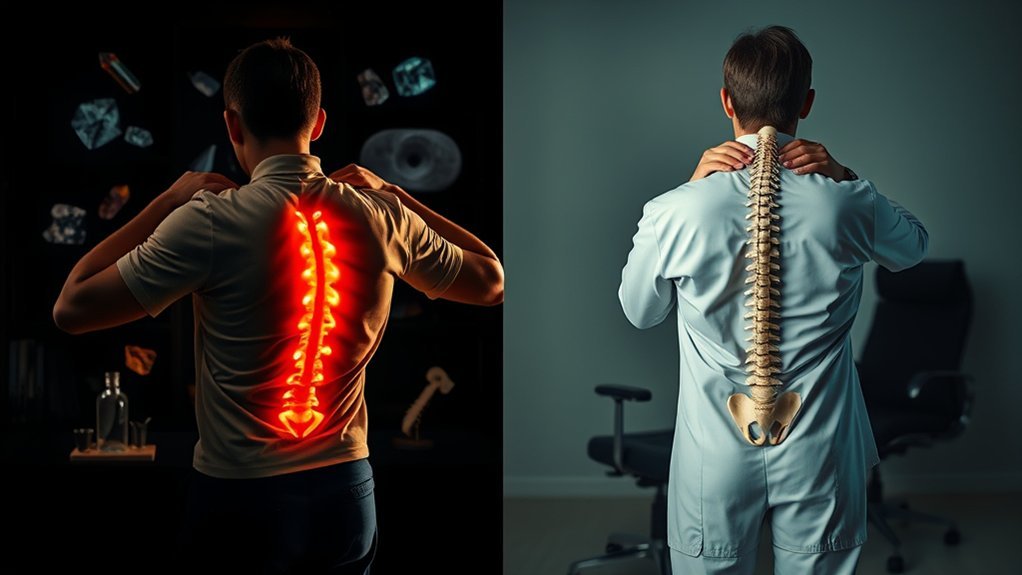Did you know that bed rest can actually exacerbate back pain instead of providing relief? Many people believe common myths about back pain that can lead to ineffective treatments. It’s essential to separate fact from fiction to find the right approach for your situation. Understanding these misconceptions can empower you to take control of your back health and explore effective strategies for relief. What are the most widespread myths that might be affecting your recovery journey?
Myth 1: Bed Rest Is the Best Solution for Back Pain

Although it might seem intuitive to rest when you’re experiencing back pain, staying active is often a more effective approach.
Research indicates that prolonged bed rest can actually worsen your condition and prolong recovery. Engaging in light activities, such as walking or gentle stretching, can help maintain mobility and prevent stiffness. These activities stimulate blood flow, which promotes healing.
Prolonged bed rest can worsen back pain; light activities like walking and stretching promote healing and prevent stiffness.
Additionally, incorporating core-strengthening exercises can provide additional support to your spine, reducing pain over time. It’s important to listen to your body and avoid high-impact activities, but don’t shy away from movement altogether.
Consult with a healthcare professional to develop a tailored activity plan that suits your needs. Remember, staying active is key to a quicker recovery from back pain.
Myth 2: Back Pain Only Affects Older Adults

You might think back pain is an issue only for older adults, but that’s simply not true.
People of all ages can experience back pain due to various factors like injury, lifestyle, or even poor posture.
Understanding that back pain doesn’t discriminate is essential for recognizing when to seek help, regardless of your age.
Age Is Not Determinant
Many people believe that back pain is an inevitable part of aging, but this myth overlooks the fact that individuals of all ages can experience back pain.
In reality, various factors contribute to back pain, irrespective of age. Here are some important points to reflect on:
- Poor posture during daily activities can lead to discomfort.
- Physical inactivity or excessive strain can strain your back.
- Injuries from sports or accidents affect younger individuals too.
- Conditions like scoliosis or herniated discs can occur at any age.
- Stress and emotional factors can also contribute to back pain.
Understanding that back pain isn’t limited to older adults empowers you to seek treatment and adopt preventive measures, ensuring a healthier back regardless of your age.
Impact on All Ages
Back pain affects people of all ages, debunking the myth that it’s solely a concern for older adults. In fact, studies show that back pain is prevalent among children, teenagers, and young adults as well.
Factors like poor posture, sports injuries, and sedentary lifestyles can lead to back issues in younger populations. If you’re in your 20s or 30s, don’t dismiss back pain as something that only older adults experience.
Early intervention is essential; addressing your back pain promptly can prevent chronic conditions later in life. Maintain a strong core, practice good ergonomics, and stay active to reduce your risk.
Recognizing that back pain can affect anyone empowers you to take proactive steps toward relief and prevention.
Myth 3: Surgery Is the Only Way to Treat Severe Back Pain

Some people believe that surgery is the only solution for severe back pain, but that’s a misconception. Many effective, non-surgical options can provide relief and improve your quality of life. These alternatives often focus on addressing the root cause of your pain and promoting healing.
- Physical therapy can strengthen muscles and improve flexibility.
- Chiropractic care may help align your spine and relieve tension.
- Medications, like NSAIDs, can reduce inflammation and pain.
- Lifestyle changes, such as weight management, can alleviate stress on your back.
- Mind-body therapies, including yoga and meditation, can enhance your overall well-being.
Always consult with a healthcare professional to explore the best treatment options tailored to your specific condition.
Myth 4: Lifting With Your Back Is Safe if You’Re Strong
While you might feel strong enough to lift heavy objects with your back, doing so can lead to serious injury regardless of your strength. The spine is designed to bear weight through proper mechanics, which involves using your legs and core muscles instead of relying solely on your back.
Research shows that improper lifting techniques can cause strains, sprains, and even long-term damage. Even physically fit individuals aren’t immune to back injuries when lifting incorrectly.
Improper lifting techniques can lead to serious injuries, even for the fittest individuals. Prioritize safe lifting to protect your back.
Instead, focus on maintaining good posture, bending at the knees, and engaging your core while lifting. Remember, being strong doesn’t replace the need for safe lifting practices.
Prioritize your spine health by using correct techniques to avoid unnecessary pain and potential injuries.
Myth 5: All Back Pain Is Caused by Injury
Many people believe that all back pain stems from an injury, but that’s not the full picture.
In fact, non-injury factors like stress and anxiety can greatly contribute to your discomfort. Understanding these psychological influences is essential for effective treatment and pain management.
Non-Injury Causes Explained
Although it’s common to associate back pain solely with injuries, numerous non-injury factors can contribute significantly to discomfort.
Understanding these causes can help you manage your pain more effectively. Here are some non-injury factors that might be affecting you:
- Poor posture: Slouching or awkward positions can strain your back over time.
- Sedentary lifestyle: Lack of movement can weaken muscles, leading to back pain.
- Obesity: Extra weight can put additional stress on your spine.
- Age-related changes: Natural wear and tear on your spine can lead to discomfort.
- Muscle imbalances: Weakness or tightness in certain muscle groups can affect spinal alignment.
Recognizing these factors is essential in addressing your back pain and finding appropriate relief strategies.
Psychological Factors Involved
Understanding that not all back pain stems from physical injuries is essential, especially since psychological factors can greatly influence your experience of pain.
Stress, anxiety, and depression can heighten your perception of pain, making it feel more intense and persistent. Research shows that individuals with negative emotional states often report more severe back pain, regardless of any physical injury.
Additionally, fear of movement or re-injury can lead to a cycle of avoidance, impairing your ability to function normally. Addressing these psychological aspects through therapy, mindfulness, or relaxation techniques can be critical for effective pain management.
Recognizing the interplay between mind and body is fundamental in your journey to finding relief from back pain.
Myth 6: Pain Medications Are the Best Long-Term Solution
While pain medications can provide temporary relief, relying on them as a long-term solution for back pain is often misguided. Over time, these medications can lead to dependency, increased tolerance, and unwanted side effects.
Instead of solely depending on medications, consider these alternative approaches:
- Physical therapy: Targeted exercises can strengthen your back and improve flexibility.
- Mind-body techniques: Practices like mindfulness and meditation can help manage pain perception.
- Lifestyle modifications: Improving posture and ergonomics can prevent exacerbation of pain.
- Alternative therapies: Acupuncture and chiropractic care may offer relief without medications.
- Education: Understanding your condition can empower you to make informed choices about your treatment.
Exploring these options will help you achieve lasting back pain relief.
Myth 7: Exercise Makes Back Pain Worse
Many people believe that exercise exacerbates back pain, but this myth can hinder recovery. In reality, regular physical activity is essential for strengthening your back muscles and improving flexibility.
Engaging in low-impact exercises, like walking or swimming, can enhance blood flow and promote healing. Studies show that individuals who remain active experience less chronic pain and improved function compared to those who avoid exercise.
It’s important to start slowly and choose activities that don’t strain your back. Consulting a healthcare professional can help you create a tailored exercise plan that considers your specific situation.
Myth 8: Chiropractic Care Is Dangerous
Chiropractic care often gets a bad reputation, with some people fearing it’s dangerous. However, research shows that when performed by trained professionals, chiropractic adjustments are safe and effective.
Here are some facts to contemplate:
- Chiropractic care is widely recognized for treating musculoskeletal issues.
- Studies indicate a low risk of serious complications from chiropractic adjustments.
- Most patients report immediate relief and improved function after treatment.
- Chiropractors undergo extensive education and training to guarantee safety.
- Regulatory bodies monitor chiropractic practices to maintain high standards.
Understanding these points can help you make informed decisions about your back pain treatment.
Instead of fearing chiropractic care, regard it as a valuable option in your path to relief.
Myth 9: Posture Is the Sole Cause of Back Pain
Although good posture plays a significant role in maintaining a healthy spine, it’s a misconception to believe that it’s the sole cause of back pain. Various factors contribute to your discomfort, including muscle imbalances, injuries, and underlying medical conditions. Understanding these influences can help you address your pain more effectively.
| Contributing Factors | Description |
|---|---|
| Muscle Imbalances | Weak or tight muscles can lead to poor alignment. |
| Injuries | Past injuries may trigger recurring pain episodes. |
| Medical Conditions | Conditions like arthritis can cause chronic pain. |
Frequently Asked Questions
What Are the Most Common Causes of Chronic Back Pain?
The most common causes of chronic back pain include muscle strain, herniated discs, arthritis, scoliosis, and injuries. Lifestyle factors like obesity, poor posture, and lack of exercise also contribute considerably to your discomfort.
How Can I Prevent Back Pain From Recurring?
To prevent back pain from recurring, you should maintain a healthy weight, exercise regularly, practice good posture, and use ergonomic furniture. Additionally, stay mindful of your movements to avoid strain and injury.
Are There Specific Exercises to Strengthen My Back?
Yes, specific exercises like bridges, planks, and rows can strengthen your back. Incorporate these into your routine, focusing on proper form. Always consult a healthcare professional before starting any new exercise program to guarantee safety.
What Alternative Therapies Are Effective for Back Pain Relief?
Alternative therapies like acupuncture, chiropractic care, and massage therapy can effectively relieve back pain. These methods often complement traditional treatments, helping you manage discomfort and improve mobility. Always consult a healthcare professional before starting new therapies.
When Should I Seek Professional Help for Back Pain?
If your back pain feels like a stubborn shadow, it’s time to seek professional help. Don’t wait if you experience severe discomfort, numbness, weakness, or if your pain persists beyond a few weeks.
Conclusion
In traversing the maze of back pain relief, it’s essential to discern fact from fiction. Think of your back as a garden; neglecting it or overwatering it both lead to problems. Just as diverse plants need tailored care, your back requires a range of treatments—from exercise to physical therapy. By embracing informed choices and seeking professional guidance, you can cultivate a healthier back, allowing you to enjoy life’s activities with ease and confidence.
